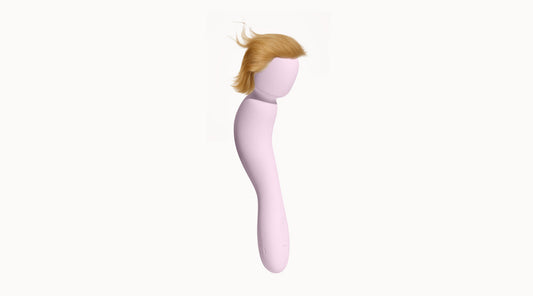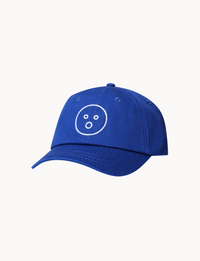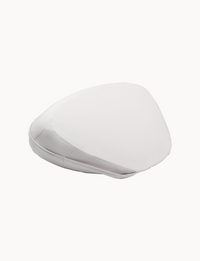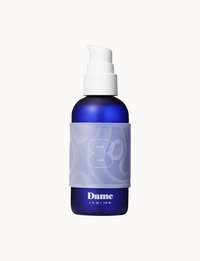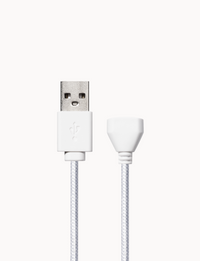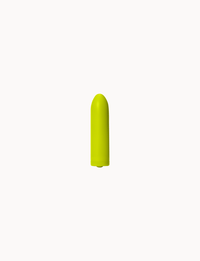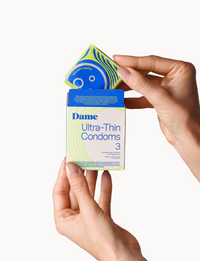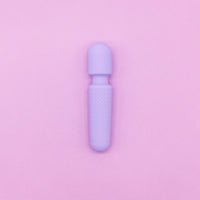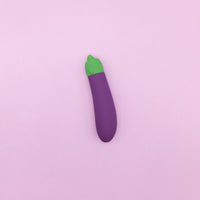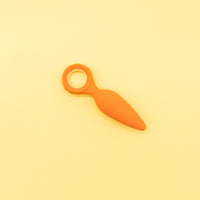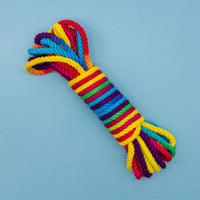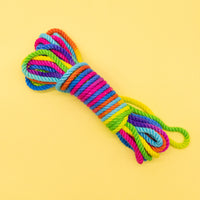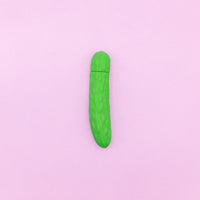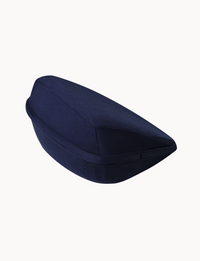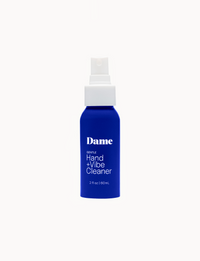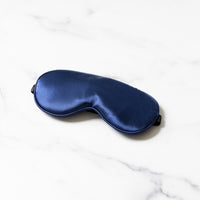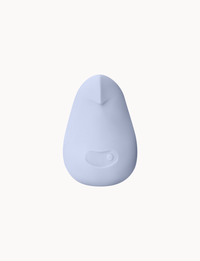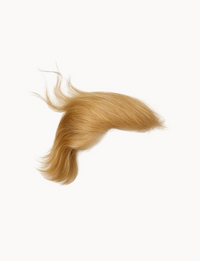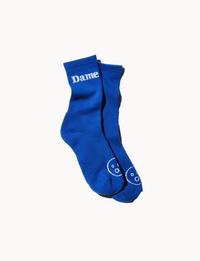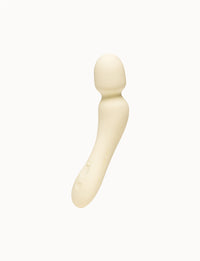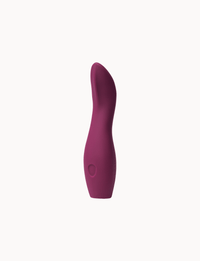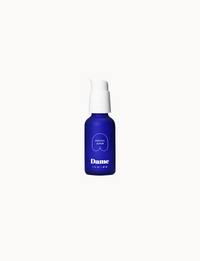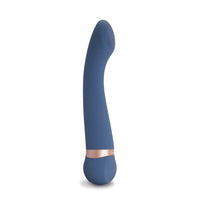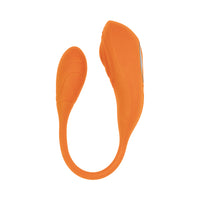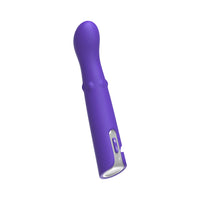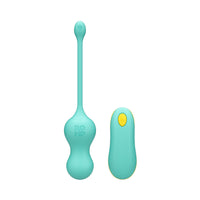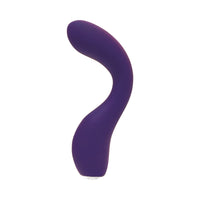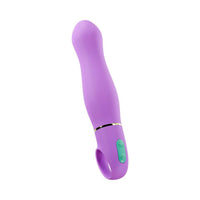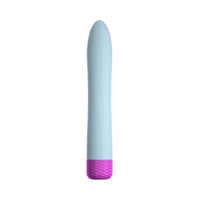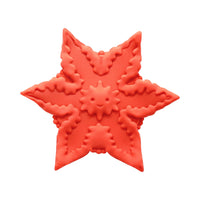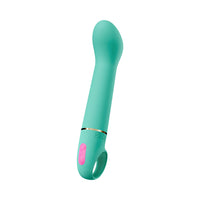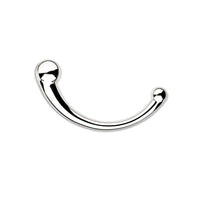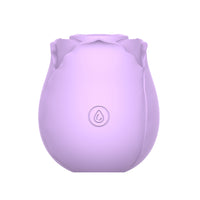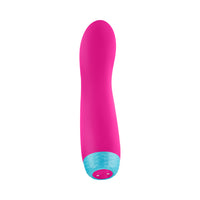Alexandra Fine, Credentialed Sexologist, M. Psych | Written by Dame
How You Can Use a Vibrator | What Types of Vibrators Can You Buy? | What Vibrator Options are Available? | Vibrator Care
That’s a question that can be answered either in clinical or practical terms.
Wikipedia does a very good job with the clinical definition: it’s a “sex toy that is used on the body to produce pleasurable sexual stimulation…an electric-powered device which pulsates or throbs.”
But you probably already knew that. Let’s get real.
- A vibrator is an electric (or electronic) sex toy.
- It can take a number of very different forms.
- It can be used on virtually any area of the body.
- It can provide or contribute to amazing sensual and sexual feelings, sensations and pleasures.
- It’s a sex toy used by more than half of the adult population, according to multiple surveys, and used even more frequently during play between vulva-owning sex partners.
The right vibrator can replicate the experience of foreplay, sex play and penetration. It can also provide you (or a partner) with sexual experiences you’ve never had before.
How do you find the “right” vibrator? The choice largely depends on what types of feelings and stimulation make you feel good.
How You Can Use a Vibrator
When people buy their first vibe, it’s not unusual for them to choose one that looks like the long, cylindrical dildo they’ve used in the past (or seen used in videos). And since it looks like it’s supposed to be inserted into an orifice, that’s where they put it after turning it on.
That may lead to a pleasurable experience, or it may not. Either way, using a penis-shaped vibrator just for solo penetrative masturbation ignores these toys’ enormous potential.
Vibrators come in a vast array of shapes and sizes, and the ways they can be used to provide pleasure are only limited by your imagination. But here are some ideas to get your juices flowing (or your erectile tissue erecting).
- Clitoral stimulation: Whether the goal is simply to get aroused or to achieve a mind-numbing orgasm, vibrators can provide just about any type of sensation to the glans clitoris. (That’s the only part of the clitoris that’s on the outside of the body, which has more than 8,000 separate nerve endings).
- Vaginal stimulation: There’s absolutely nothing wrong, of course, with taking that vibrator we mentioned and using it inside the vagina to simulate penetration, or to more directly target the G-spot or the A-spot. (Yes, there’s really one of those, about two inches deeper than the G-spot).
- Vulva stimulation: Other parts of the vulva need love, too – or at least, they respond well to it. There are numerous erogenous zones other than the glans clitoris in the vulva, and the sensations of a vibrator used on them can range from arousing to satisfying. Think of the labia (both the inner and outer lips), the clitoral hood and the mons pubis (the mound above the glans) as territory ripe for exploration, which can provide great rewards.
- Anal stimulation: The penis-shaped vibrator we keep mentioning may be too wide to fit nicely into the anus, but “there’s a vibrator for that” as well. And if you’ve resolved never to unlock the back door, the perineum (the area between the vulva and anus), the rim and even the buttocks are all sensitive and usually respond to the feeling of a vibrator.
- Other erogenous zones: “Vibrator” and “genitals” don’t have to be used together, either in a sentence or in practice. The sensations produced by a vibe can be deeply arousing and even satisfying just about anywhere on the body: the nipples, the inner thighs, the neck, the small of the back, the scalp – well, as we suggested earlier, use your imagination. You know which parts of your body tingle and respond better than we do.
You’ve certainly noticed that so far, we’ve primarily discussed the ways that vulva owners can use a vibrator. But vibes are for everyone.
Those with a penis can find vibrators that will stimulate just about every part of their genitals, from the head and shaft to the testicles and scrotum, and there are anal vibrators that can stimulate the prostate and deliver one of the strongest orgasms possible. Of course, all of the other erogenous zones on penis-havers are also sensitive and welcoming areas for vibrators, too.
There’s one important way to use vibrators we haven’t mentioned yet, and many people find it’s the best way: with a partner (or partners). Using a vibe to pleasure your partner can not only make both of you happy and satisfied, but it can open up new discussions about your bodies and your sex life. Mutual masturbation or reciprocal stimulation can be both fun and intense. And there are even vibrators designed to provide sexual pleasure to both partners at the same time.
So – what is a vibrator? It’s a versatile sex toy that can be almost anything you want it to be, and can provide just about every type of pleasure you can imagine.
What Types of Vibrators Can You Buy?
Now that you know that vibrators aren’t just penis-shaped toys or vibrating dildos, it’s time to wander through the wonderland of vibrating sex toys available at your local sex shop, on Amazon – or even better – on the web sites of companies which specialize in these devices like Dame Products, Babeland or Lovehoney.
-
Internal Vibrators: We might as well start with the category that includes the cylindrical-shaped toys we keep mentioning. Of course, they’re designed primarily to fit into the vagina in order to provide internal stimulation by simulating intercourse or other types of vaginal penetration.
The most interesting models, though, are slightly curved G-spot vibrators with flat tips; their shape allows them to contact the front part of the vaginal wall (where most experts believe the sweet spot is located) to provide G-spot stimulation. If you’re curious about the A-spot we mentioned earlier, it’s about two inches past the G-spot so you’ll need a long vibrator to reach it.
-
External Vibrators: There’s no single way to describe an external vibrator because they are made in many different styles, and are designed to stimulate different areas of the genitals in different ways. You’ll often see them referred to as clitoral vibrators, because they’re most often used on the glans clitoris to enhance arousal or produce orgasm.
The most popular models are bullet vibrators, which are smaller than internal vibes and meant to stimulate a single area of the glans or vulva at one time; magic wand vibrators, quite big with a large head and able to deliver a powerful experience (frankly, too powerful for some vulvas); and small palm massagers, meant (of course) to stimulate your genitals and not your palm.
External vibrators are particularly useful for use on other erogenous zones as well. That’s not surprising because one of the first ever produced, the Hitachi Magic Wand, was originally sold in the 1960s as a tool for muscle relaxation. Its popularity really soared, though, once people realized where else it could be used.
-
Combination Vibrators: Pleasure is good, but twice the pleasure is twice as nice. Combination vibrators prove the truth of that statement, since they’re designed to stimulate two different erogenous zones at the same time – something that most vulva owners find either necessary or desirable. The most common example is the extremely-popular rabbit vibrator, whose body is an internal vibe, with attached “rabbit ears” to pleasure the glans clitoris simultaneously.
For the more adventurous, there are vibrators which can hit the anus at the same time as the vagina and glans, and models for penis owners which stimulate the scrotum, perineum and anus all at once.
-
Anal Vibrators: Since the anus is narrower than the vagina and takes longer to open for penetration, anal vibrators are typically slimmer than internal ones. They have an additional feature, too: a flared base that prevents them from being lost in the anus or rectum. There are several other types of vibrating toys designed for the anus as well, including small anal probes, vibrating butt plugs and even vibrating anal beads. For those with prostates, some anal vibrators are designed specifically to hit that very erogenous internal gland.
-
Oral Sex Simulators: The number of toys in this category has grown substantially over the last few years. Most are not actually vibrators, but instead provide suction on the glans clitoris to create a feeling very similar to cunnilingus. Others have even more ingenious designs, including one with a rotating set of “tongues,” and another which attaches to a partner’s tongue to make it even more “active” while they’re performing oral sex.
-
Vibrators for Penis Owners: Vibrating cock rings and Fleshlight sleeves for masturbating have been around for quite a while. There are other alternatives as well; they include blow job simulators which range from the simple to the somewhat scary-looking, and the prostate vibrators mentioned earlier.
-
Vibrators for Partners: We’ve suggested several times that you let your imagination run wild – that’s what sex toy designers have done to come up with products to be used by more than one person. Vibrators worn internally while having penetrative sex? Vibrating panties or inserts that a partner can control with a remote control or their phone? A vibrating cock ring combined with a bullet vibrator? Vibrating double-headed dildos? Yeah, they’ve got that.
And of course, these categories don’t restrict the ways you can use vibrators. Have we already suggested that you use your imagination to maximize the sexual arousal and pleasure you can experience when playing with your new toy? OK, just wanted to make sure.
What Vibrator Options are Available?
When you’re picking out a vibrator, there’s more to choose than just its style.
Naturally, you’ll find a wide variety of speeds. Some inexpensive models may just have an “on-off” or “high-low” switch. Fancy ones may offer 10 speeds or even more. There are vibrators that feature different modes like pulsing or thrusting, different patterns of vibration, or options that alternate speeds and motions to make the experience more unpredictable and satisfying.
Most vibrators have a single motor to provide the vibrations, but you can also choose a vibrator with two motors to control two different functions independently. For example, a rabbit may have one variable speed control for the internal vibrator and another for the clitoris stimulator, each powered by different motors.
Whether you prefer a smooth or textured vibrator, you should have no trouble finding one you like. A thornier issue is what the vibe is made from. Many softer (and more comfortable) models are made from porous materials, which can retain microscopic bacteria in the pores even after a good cleaning. Latex is less porous, but smells bad and is obviously an issue for those with latex allergies. If you’re going to use toys made from any of those materials, covering them with a condom makes sense.
Harder, non-porous materials like steel, ABS plastic and silicone don’t pose those issues. Medical-grade silicone is the softest and highest-quality option (but be sure not to use silicone-based lube with silicone toys – it will damage them). At the opposite end of the “best vibrators” spectrum are jelly-rubber vibes, some of which contain phthalates or other toxic chemicals and most of which have been pulled from the market.
You may also have to make a few other choices.
- Cordless rechargeable vibrators are the most convenient, those which run on disposable batteries will usually run longer in one session, and those that must be plugged in (usually large external vibes) are more powerful but leave you tethered to the wall or a power cord.
- A waterproof toy is easier to clean and can be brought into the shower or tub, but not all vibrators are available in waterproof or water-resistant models.
- You’ll probably have to pay extra for vibes with advanced features like remote controls or apps, but they can take your sex play to a new level.
What Is a Vibrator That Hasn’t Been Properly Cared For?
Dangerous.
You already know that bacteria and bodily fluids can hide in the pores of many vibrators. They can also live right on the surface of non-porous models that haven’t been cleaned thoroughly.
That’s a prescription for bacterial vaginosis, yeast infections and UTIs – probably not what you bargained for when you decided to give your vibrator a good workout. Even worse, it’s been shown that dirty sex toys can transmit STDs, particularly HPV.
Cleaning a vibrator may be an annoyance when you’re worn out from a session of sex play and just want to roll over and relax, but we don’t have to tell you that infections and STDs are even more of an annoyance. Taking a few minutes to clean your vibrator afterward can save you days, weeks or months of regrets.
A good scrub with soap and water, being careful not to get electronic or mechanical parts soaked, will almost always do the trick. If you’re cleaning a vibrator made from porous materials, a bottle of sex toy cleaner that contains an anti-bacterial agent might be a good investment. Don’t use scented soaps, which could irritate the genitals on the next go-round, or antibacterial soaps which may contain the hormone-disruptor Triclosan.
Let the vibe air dry or wipe it thoroughly with a clean cloth, store it in a clean case, and you’ll have nothing to worry about when the urge hits you to pull it again.



